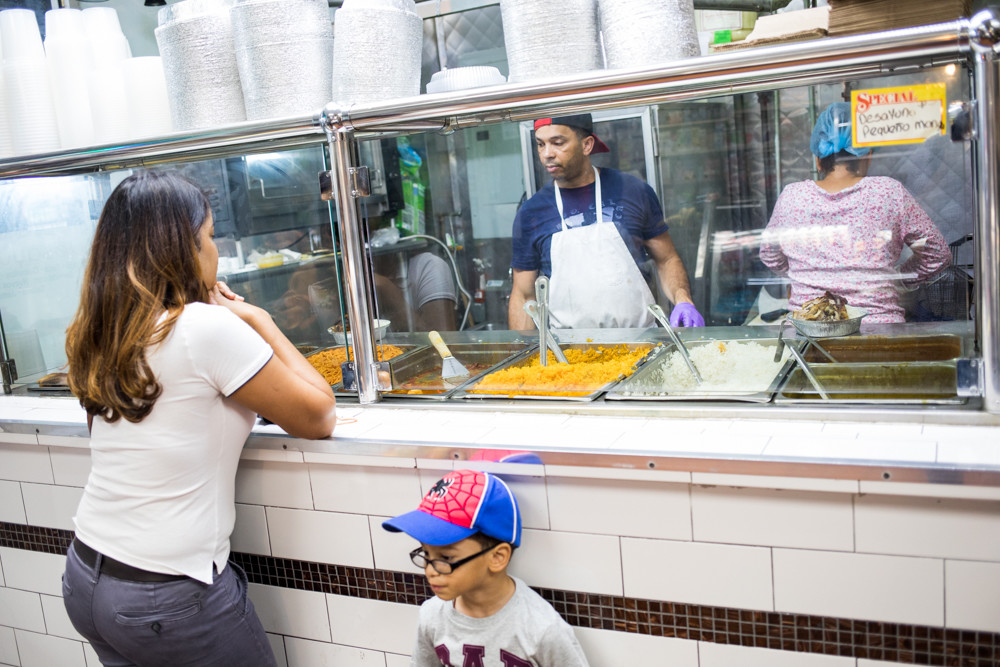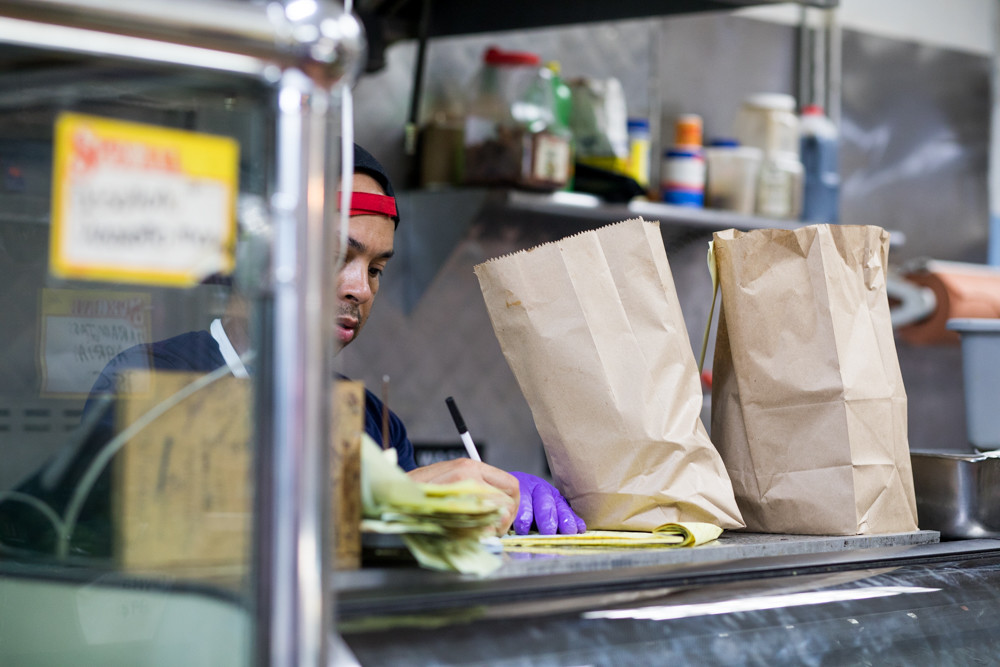Defying decades of odds, yet state could help more
It seems little short of a miracle the Taveras Food Center, on an oft-buzzing strip of Broadway, has been feeding Marble Hill mouths for as long as it has — at least 25 years, says manager Jose Taveras.
These days, Taveras mans the family business’ hot food station piling succulent pork, goat, steak, atop mounds of white and yellow rice, drowned in beans. There’s pasta, baked salmon, chicken, packed into aluminum containers for ravenous residents to dig in right at the counter.
The influx of orders is constant as Taveras and a raspy voiced employee take turns answering the phone. Two members of a small team operating a well-oiled machine, a kitchen — like the neighborhood it serves — constantly humming.
Tucked beneath the elevated subway tracks just north of West 225th Street, perhaps the joint’s longevity isn’t such a miracle, given — as Taveras proudly proclaims, in Spanish — “We have everything.”
Not just the hot, heaping provisions — all casera, homemade — but groceries, impeccably lined shelves of colorful Goya products, from beets, to green peas to olives, to beans — black, pinto, kidney. Even scented candles.
But Taveras’ food hub is just one among legions of small businesses in Marble Hill, and the rest of the borough, city and state, struggling to stay afloat amidst ever-increasing rents in a cut-throat, rapidly shifting economic landscape.
“It’s the rent and the taxes that are killing us,” said Frank Taveras, Jose’s brother, in Spanish, as he works the register. Bills add up — water, electricity — and stress. What if health department inspectors waltz in and smack them with a crippling fine, for any number of potential slip-ups, from storing pork at the wrong temperature, to an improperly calibrated thermometer?
But Taveras Food Center isn’t the only one struggling. And its plight might not just be that running a small business is hard.
Glaring racial disparities exist in at least one major state economic development program, according to a report released in August by nonpartisan think tank, the Fiscal Policy Institute, and immigrants rights advocacy group Make the Road New York.
Even as the state has dumped billions of dollars into economic development and heralded a resurgence of once downtrodden areas, money awarded through Gov. Andrew Cuomo’s Regional Economic Development Council initiative — which calls for councils representing 10 regions around the state to compete for funding — has seeped disproportionately into predominantly white communities, the report said.
That comes at a time when scandals continue to mar the state’s efforts to revitalize anemic economies.
The report focuses on racial disparities in spending specifically for Cuomo’s economic development councils, said Ron Deutsch, executive director of the Fiscal Policy Institute, but didn’t include other economic development spending. It examined funding allocated to each of the state’s 10 economic development regions through the councils over the past seven years.
While the total amount awarded to each region was roughly similar — between $460 million and $615 million — the amount per resident varied highly.
Areas with higher concentrations of people of color, like the Bronx, are getting less money per capita than other, whiter areas of the state, Deutsch said, proving there’s “little rhyme or reason” in how the state distributes economic development funding.
“Shouldn’t we be looking at investing more in areas with high unemployment, high poverty levels and failing local economies?” Deutsch asked. “If we did, the Bronx would be at the top of the list for economic development incentives.”
Deutsch criticized what he described as the state’s distributing similar amounts of funding by region, without regard to population or need, as well as making regions compete for money.
“We are not saying the North Country shouldn’t get the funding it needs to address problems with its regional economy,” Deutsch said. “Rather, there needs to be a rational way to distribute funds that is not politically biased but … based on solid metrics.”
Immigrants are a little more likely to own businesses than their U.S.-born counterparts, but much more likely to own “main street businesses” like grocery stores, restaurants and barbershops, Deutsch added, pointing to a 2015 study his institute released with the Americas Society.
“Perhaps we should be figuring out ways to invest in helping immigrants and people of color start or expand their businesses in the Bronx,” Deutsch said.
In fact, some programs that help people of color and immigrants develop business plans and secure startup funding actually already exist in the state, Deutsch said, but suffer from inadequate funding.
“We need a bottom-up economic development plan, rather than a top-down plan,” Deutsch said, since the latter “has proven to be ineffective, costly and prone to corruption.”
In other words, a reliable means of tracking economic development spending to make sure it’s spent wisely, effectively and rationally, Deutsch said, which is why his institute has been calling for the state to establish a “database of deals” containing all economic development subsidies, showing which businesses are getting them, and whether or not they’re creating the number of jobs they promised.
“Only then will we truly know if we are getting a good return on our investment,” Deutsch said, “and whether or not the programs the governor claims are a historic success are actually working.”
Until they do, Taveras will keep busy doing what’s helped his business survive decades — quelling rumbling bellies under the rumbling 1.
The key to his success? That’s no secret.
“Work hard.”













